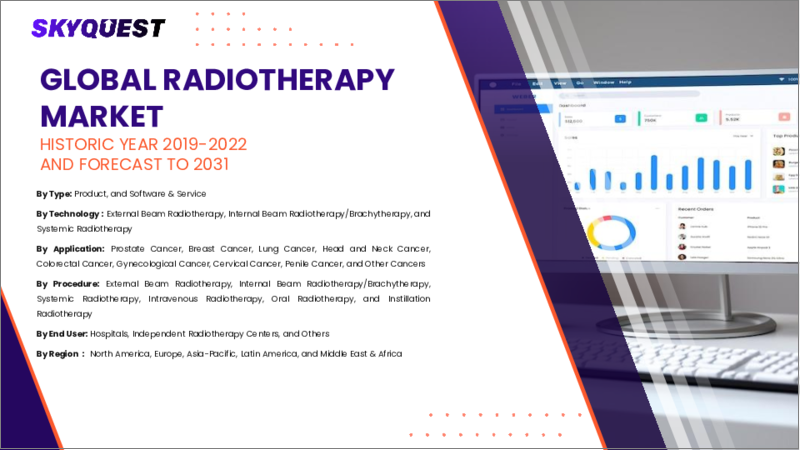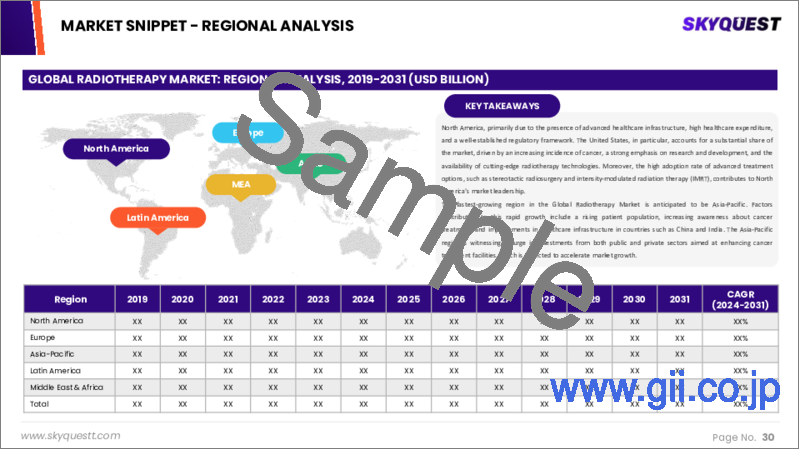|
|
市場調査レポート
商品コード
1373812
放射線治療の世界市場 (2023-2030年):技術 (外照射・内照射)・エンドユーザー (病院・独立系放射線治療センター) 別の規模・シェア・成長分析・予測Global Radiotherapy Market Size, Share, Growth Analysis, By Technology(External Beam Radiotherapy and Internal Beam Radiotherapy), By End-User(Hospitals and Independent Radiotherapy Centers) - Industry Forecast 2023-2030 |
||||||
|
|||||||
| 放射線治療の世界市場 (2023-2030年):技術 (外照射・内照射)・エンドユーザー (病院・独立系放射線治療センター) 別の規模・シェア・成長分析・予測 |
|
出版日: 2023年10月16日
発行: SkyQuest
ページ情報: 英文 157 Pages
納期: 3~5営業日
|
- 全表示
- 概要
- 目次
世界の放射線治療の市場規模は、2021年の77億米ドル、2022年の85億6,000万米ドルから、予測期間中は12.3%のCAGRで推移し、2030年には245億7,000万米ドルの規模に成長すると予測されています。
世界の放射線治療の市場は、ヘルスケア産業の中で急成長している分野であり、高エネルギーの放射線を正確に癌細胞に照射することで、癌細胞を消滅させたり、増殖を抑えたりします。放射線治療の需要は、いくつかの理由から世界規模で一貫して高まっています。まず、世界的に癌の有病率が増加しており、効果的な治療オプションに対する需要が高まっています。世界保健機関 (WHO) によると、癌は世界の死亡原因の上位にランクされており、新規患者数は今後も増え続けると予測されています。第二に、技術と医療機器の進歩により、放射線治療の精度と有効性が大幅に向上しました。強度変調放射線治療 (IMRT) 、定位放射線手術 (SRS) 、陽子線治療などの革新的技術により、より正確な治療が可能になり、健康な組織への害を最小限に抑え、患者の副作用を軽減することができるようになっています。
世界市場では有望な機会が示される一方で、いくつかの課題にも直面しています。これには、装置の高価格性、特定地域でのアクセスの制限、放射線治療に伴う潜在的な副作用などがあります。しかし、現在進行中のR&Dでは、これらの課題に取り組み、放射線治療全体の有効性と安全性を高めることを目指しています。
当レポートでは、世界の放射線治療の市場を調査し、市場概要、市場への各種影響因子の分析、技術・イノベーションの動向、法規制環境、市場規模の推移・予測、各種区分・地域別の内訳、競合情勢、主要企業のプロファイルなどをまとめています。
目次
- エグゼクティブサマリー
- 調査手法
- 親市場の分析
- 市場概要
- 市場規模
- 市場力学
- 促進要因
- 機会
- 抑制要因
- 課題
- 主要な市場洞察
- 技術分析
- 価格分析
- サプライチェーン分析
- バリューチェーン分析
- 市場のエコシステム
- IP分析
- 貿易分析
- スタートアップ分析
- 原材料分析
- イノベーションマトリックス
- パイプライン製品の分析
- マクロ経済指標
- 主要投資分析
- 主要な成功要因
- 競合の程度
- 市場力学と見通し
- 市場力学
- 促進要因
- 機会
- 抑制要因
- 課題
- 市場力学
- 規制状況
- ポーターの分析
- 将来のディスラプションに関するSkyquestの特別な洞察
- 世界の放射線治療市場:技術別
- 市場概要
- 外照射
- 内照射
- 世界の放射線治療市場:エンドユーザー別
- 市場概要
- 病院
- 独立系放射線治療センター
- 世界の放射線治療市場:地域別
- 市場概要
- 北米
- 欧州
- アジア太平洋
- ラテンアメリカ
- 中東・アフリカ
- 競合情勢
- 上位5社の比較
- 主要企業の市場での位置付け
- 主要企業の採用戦略
- 主要成功戦略
- 市場における最近の活動
- 主要企業の市場シェア
- 主要企業プロファイル
- Varian Medical Systems, Inc.
- Mevion Medical Systems
- ViewRay Technologies, Inc. ("ViewRay")
- Siemens Healthcare GmbH
- Accuray Incorporated
- IBA Worldwide
- Eckert & Ziegler
- Koninklijke Philips N.V.
- General Electric
- Hitachi, Ltd.
- Advanced Accelerator Applications
- CIVCO Medical Solutions
- Isoray Inc.
- Elekta AB
- Panacea Medical Technologies Pvt. Ltd.
- Optivus Proton Therapy, Inc.
- P-Cure, Ltd.
- Nordion, Inc.
- NTP Radioisotopes SOC Ltd.
- Curium
Global Radiotherapy Market size was valued at USD 7.7 billion in 2021 and is poised to grow from USD 8.56 billion in 2022 to USD 24.57 billion by 2030, growing at a CAGR of 12.3% during the forecast period (2023-2030).
The global radiotherapy market is a swiftly growing sector within the healthcare industry, focusing on the use of radiation for treating various types of cancer. This form of treatment, also known as radiation therapy, entails delivering high-energy radiation precisely to cancerous cells, either eliminating them or impeding their growth. The demand for radiotherapy has been consistently rising on a worldwide scale for several reasons. Firstly, there has been an increase in the prevalence of cancer globally, leading to a higher demand for effective treatment options. According to the World Health Organization (WHO), cancer ranks among the top causes of global mortality, and the number of new cases is projected to continue rising. Secondly, advancements in technology and medical equipment have significantly improved the accuracy and effectiveness of radiotherapy. Innovative techniques like intensity-modulated radiation therapy (IMRT), stereotactic radiosurgery (SRS), and proton therapy have enabled more precise delivery of treatment, minimizing harm to healthy tissues and reducing side effects for patients. While the global market offers promising opportunities, it also encounters certain challenges. These include the high cost of equipment, limited accessibility in specific regions, and potential side effects associated with radiation therapy. Nonetheless, ongoing efforts in research and development aim to tackle these challenges and enhance the overall effectiveness and safety of radiotherapy.
Top-down and bottom-up approaches were used to estimate and validate the size of the global radiotherapy Market and to estimate the size of various other dependent submarkets. The research methodology used to estimate the market size includes the following details: The key players in the market were identified through secondary research, and their market shares in the respective regions were determined through primary and secondary research. This entire procedure includes the study of the annual and financial reports of the top market players and extensive interviews for key insights from industry leaders such as CEOs, VPs, directors, and marketing executives. All percentage shares split, and breakdowns were determined by using secondary sources and verified through Primary sources. All possible parameters that affect the markets covered in this research study have been accounted for, viewed in extensive detail, verified through primary research, and analyzed to get the final quantitative and qualitative data.
Segments covered in this report
Global Radiotherapy Market is segmented by Technology, end-user, and region. Based on Technology, the market can be segmented into external beam radiotherapy and internal beam radiotherapy. Based on end-user, the market is segmented into hospitals and independent radiotherapy centers. Based on region, the market is segmented into North America, Europe, Asia Pacific, Middle East and Africa, and Latin America.
Drivers:
Increasing Demand for External-Beam Radiation Therapy
Because of its increasing application in the management of numerous cancer types, such as lung, prostate, breast, colon, liver, thyroid, lymphoma, brain, and spine cancers, there is a significant surge in demand for external-beam radiation therapy. Among the various radiation therapy modalities employed in cancer treatment, external-beam radiation therapy stands out as one of the most commonly utilized methods. This technique directs high-energy external radiation precisely to the tumor site, which consequently fuels the growth of the market.
Restraints:
Lack of Skilled Oncologists and Technicians
Skilled medical professionals are essential for the successful implementation of advanced radiotherapy techniques in patient treatment. The shortage of qualified personnel and technical expertise is expected to impede the growth of the market for sophisticated radiation therapies. A significant shortage of oncologists exacerbates this issue.
Market Trends:
The global radiotherapy market is witnessing significant developments that are influencing its expansion and evolution. A prominent trend in this field involves the growing utilization of advanced technologies like IMRT, IGRT, and proton therapy. These innovations enable more precise and focused treatment delivery, resulting in enhanced outcomes and diminished adverse effects.
Another notable trend involves the incorporation of radiotherapy into a broader spectrum of treatment modalities. Combination therapies, which involve merging radiotherapy with surgical procedures, chemotherapy, immunotherapy, or targeted therapies, are on the rise in terms of popularity. This holistic approach seeks to optimize the efficacy of cancer treatment by harnessing various strategies. There is a growing emphasis on patient-centered care and enhancing the quality of life, with a dedicated focus on minimizing adverse effects through the use of advanced treatment planning and delivery methods.
Table of Contents
- Executive Summary
- Market Overview
- Wheel of Fortune
- Research Methodology
- Information Procurement
- Secondary & Primary Data Sources
- Market Size Estimation
- Market Assumptions & Limitations
- Parent Market Analysis
- Market Overview
- Market Size
- Market Dynamics
- Drivers
- Opportunities
- Restraints
- Challenges
- Key Market Insights
- Technology Analysis
- Pricing Analysis
- Supply Chain Analysis
- Value Chain Analysis
- Ecosystem of the Market
- IP Analysis
- Trade Analysis
- Startup Analysis
- Raw Material Analysis
- Innovation Matrix
- Pipeline Product Analysis
- Macroeconomic Indicators
- Top Investment Analysis
- Key Success Factor
- Degree of Competition
- Market Dynamics & Outlook
- Market Dynamics
- Drivers
- Opportunities
- Restraints
- Challenges
- Regulatory Landscape
- Porters Analysis
- Competitive rivalry
- Threat of Substitute Products
- Bargaining Power of Buyers
- Threat of New Entrants
- Bargaining Power of Suppliers
- Skyquest Special Insights on Future Disruptions
- Political Impact
- Economic Impact
- Social Impact
- Technical Impact
- Environmental Impact
- Legal Impact
- Global Radiotherapy Market by Technology
- Market Overview
- External Beam Radiotherapy and Internal Beam Radiotherapy
- Global Radiotherapy Market by End-User
- Market Overview
- Hospitals and Independent Radiotherapy Centers
- Global Radiotherapy Market Size by Region
- Market Overview
- North America
- USA
- Canada
- Europe
- Germany
- Spain
- France
- UK
- Rest of Europe
- Asia Pacific
- China
- India
- Japan
- South Korea
- Rest of Asia-Pacific
- Latin America
- Brazil
- Rest of Latin America
- Middle East & Africa (MEA)
- GCC Countries
- South Africa
- Rest of MEA
- Competitive Landscape
- Top 5 Player Comparison
- Market Positioning of Key Players, 2021
- Strategies Adopted by Key Market Players
- Top Winning Strategies
- By Development
- By Company
- By Year
- Recent Activities in the Market
- Key Companies Market Share (%), 2021
- Key Company Profiles
- Varian Medical Systems, Inc. (U.S.)
- Company Overview
- Business Segment Overview
- Financial Updates
- Key Developments
- Mevion Medical Systems (U.S.)
- Company Overview
- Business Segment Overview
- Financial Updates
- Key Developments
- ViewRay Technologies, Inc. ("ViewRay") (U.S.)
- Company Overview
- Business Segment Overview
- Financial Updates
- Key Developments
- Siemens Healthcare GmbH (Germany)
- Company Overview
- Business Segment Overview
- Financial Updates
- Key Developments
- Accuray Incorporated (U.S.)
- Company Overview
- Business Segment Overview
- Financial Updates
- Key Developments
- IBA Worldwide (Belgium)
- Company Overview
- Business Segment Overview
- Financial Updates
- Key Developments
- Eckert & Ziegler (Germany)
- Company Overview
- Business Segment Overview
- Financial Updates
- Key Developments
- Koninklijke Philips N.V. (Netherlands)
- Company Overview
- Business Segment Overview
- Financial Updates
- Key Developments
- General Electric (U.S.)
- Company Overview
- Business Segment Overview
- Financial Updates
- Key Developments
- Hitachi, Ltd. (Japan)
- Company Overview
- Business Segment Overview
- Financial Updates
- Key Developments
- Advanced Accelerator Applications (France)
- Company Overview
- Business Segment Overview
- Financial Updates
- Key Developments
- CIVCO Medical Solutions (U.S.)
- Company Overview
- Business Segment Overview
- Financial Updates
- Key Developments
- Isoray Inc. (U.S.)
- Company Overview
- Business Segment Overview
- Financial Updates
- Key Developments
- Elekta AB (Sweden)
- Company Overview
- Business Segment Overview
- Financial Updates
- Key Developments
- Panacea Medical Technologies Pvt. Ltd. (India)
- Company Overview
- Business Segment Overview
- Financial Updates
- Key Developments
- Optivus Proton Therapy, Inc. (U.S.)
- Company Overview
- Business Segment Overview
- Financial Updates
- Key Developments
- P-Cure, Ltd. (Israel)
- Company Overview
- Business Segment Overview
- Financial Updates
- Key Developments
- Nordion, Inc. (Canada)
- Company Overview
- Business Segment Overview
- Financial Updates
- Key Developments
- NTP Radioisotopes SOC Ltd. (South Africa)
- Company Overview
- Business Segment Overview
- Financial Updates
- Key Developments
- Curium (France)
- Company Overview
- Business Segment Overview
- Financial Updates
- Key Developments






